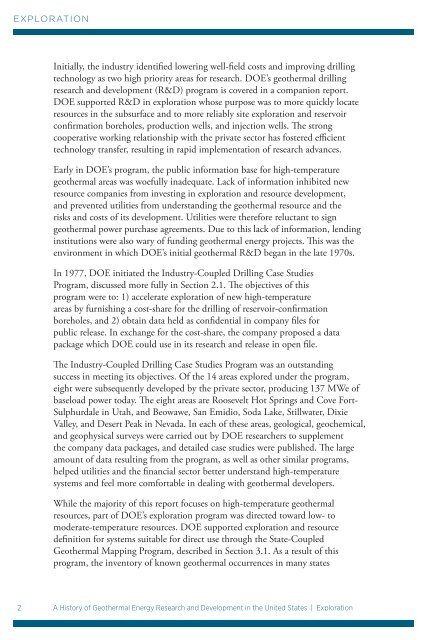A History of Geothermal Energy Research and Development in the ...
A History of Geothermal Energy Research and Development in the ...
A History of Geothermal Energy Research and Development in the ...
Create successful ePaper yourself
Turn your PDF publications into a flip-book with our unique Google optimized e-Paper software.
EXPLORATION<br />
Initially, <strong>the</strong> <strong>in</strong>dustry identified lower<strong>in</strong>g well-field costs <strong>and</strong> improv<strong>in</strong>g drill<strong>in</strong>g<br />
technology as two high priority areas for research. DOE’s geo<strong>the</strong>rmal drill<strong>in</strong>g<br />
research <strong>and</strong> development (R&D) program is covered <strong>in</strong> a companion report.<br />
DOE supported R&D <strong>in</strong> exploration whose purpose was to more quickly locate<br />
resources <strong>in</strong> <strong>the</strong> subsurface <strong>and</strong> to more reliably site exploration <strong>and</strong> reservoir<br />
confirmation boreholes, production wells, <strong>and</strong> <strong>in</strong>jection wells. The strong<br />
cooperative work<strong>in</strong>g relationship with <strong>the</strong> private sector has fostered efficient<br />
technology transfer, result<strong>in</strong>g <strong>in</strong> rapid implementation <strong>of</strong> research advances.<br />
Early <strong>in</strong> DOE’s program, <strong>the</strong> public <strong>in</strong>formation base for high-temperature<br />
geo<strong>the</strong>rmal areas was woefully <strong>in</strong>adequate. Lack <strong>of</strong> <strong>in</strong>formation <strong>in</strong>hibited new<br />
resource companies from <strong>in</strong>vest<strong>in</strong>g <strong>in</strong> exploration <strong>and</strong> resource development,<br />
<strong>and</strong> prevented utilities from underst<strong>and</strong><strong>in</strong>g <strong>the</strong> geo<strong>the</strong>rmal resource <strong>and</strong> <strong>the</strong><br />
risks <strong>and</strong> costs <strong>of</strong> its development. Utilities were <strong>the</strong>refore reluctant to sign<br />
geo<strong>the</strong>rmal power purchase agreements. Due to this lack <strong>of</strong> <strong>in</strong>formation, lend<strong>in</strong>g<br />
<strong>in</strong>stitutions were also wary <strong>of</strong> fund<strong>in</strong>g geo<strong>the</strong>rmal energy projects. This was <strong>the</strong><br />
environment <strong>in</strong> which DOE’s <strong>in</strong>itial geo<strong>the</strong>rmal R&D began <strong>in</strong> <strong>the</strong> late 1970s.<br />
In 1977, DOE <strong>in</strong>itiated <strong>the</strong> Industry-Coupled Drill<strong>in</strong>g Case Studies<br />
Program, discussed more fully <strong>in</strong> Section 2.1. The objectives <strong>of</strong> this<br />
program were to: 1) accelerate exploration <strong>of</strong> new high-temperature<br />
areas by furnish<strong>in</strong>g a cost-share for <strong>the</strong> drill<strong>in</strong>g <strong>of</strong> reservoir-confirmation<br />
boreholes, <strong>and</strong> 2) obta<strong>in</strong> data held as confidential <strong>in</strong> company files for<br />
public release. In exchange for <strong>the</strong> cost-share, <strong>the</strong> company proposed a data<br />
package which DOE could use <strong>in</strong> its research <strong>and</strong> release <strong>in</strong> open file.<br />
The Industry-Coupled Drill<strong>in</strong>g Case Studies Program was an outst<strong>and</strong><strong>in</strong>g<br />
success <strong>in</strong> meet<strong>in</strong>g its objectives. Of <strong>the</strong> 14 areas explored under <strong>the</strong> program,<br />
eight were subsequently developed by <strong>the</strong> private sector, produc<strong>in</strong>g 137 MWe <strong>of</strong><br />
baseload power today. The eight areas are Roosevelt Hot Spr<strong>in</strong>gs <strong>and</strong> Cove Fort-<br />
Sulphurdale <strong>in</strong> Utah, <strong>and</strong> Beowawe, San Emidio, Soda Lake, Stillwater, Dixie<br />
Valley, <strong>and</strong> Desert Peak <strong>in</strong> Nevada. In each <strong>of</strong> <strong>the</strong>se areas, geological, geochemical,<br />
<strong>and</strong> geophysical surveys were carried out by DOE researchers to supplement<br />
<strong>the</strong> company data packages, <strong>and</strong> detailed case studies were published. The large<br />
amount <strong>of</strong> data result<strong>in</strong>g from <strong>the</strong> program, as well as o<strong>the</strong>r similar programs,<br />
helped utilities <strong>and</strong> <strong>the</strong> f<strong>in</strong>ancial sector better underst<strong>and</strong> high-temperature<br />
systems <strong>and</strong> feel more comfortable <strong>in</strong> deal<strong>in</strong>g with geo<strong>the</strong>rmal developers.<br />
While <strong>the</strong> majority <strong>of</strong> this report focuses on high-temperature geo<strong>the</strong>rmal<br />
resources, part <strong>of</strong> DOE’s exploration program was directed toward low- to<br />
moderate-temperature resources. DOE supported exploration <strong>and</strong> resource<br />
def<strong>in</strong>ition for systems suitable for direct use through <strong>the</strong> State-Coupled<br />
<strong>Geo<strong>the</strong>rmal</strong> Mapp<strong>in</strong>g Program, described <strong>in</strong> Section 3.1. As a result <strong>of</strong> this<br />
program, <strong>the</strong> <strong>in</strong>ventory <strong>of</strong> known geo<strong>the</strong>rmal occurrences <strong>in</strong> many states<br />
2 A <strong>History</strong> <strong>of</strong> <strong>Geo<strong>the</strong>rmal</strong> <strong>Energy</strong> <strong>Research</strong> <strong>and</strong> <strong>Development</strong> <strong>in</strong> <strong>the</strong> United States | Exploration

















